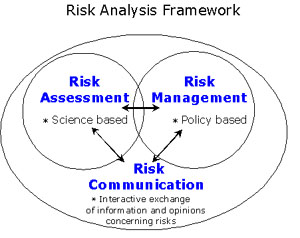Food safety-risk analysis
Food Safety-Risk Analysis is a critical aspect of public health and food science that involves understanding, evaluating, and managing the risks associated with foodborne hazards. This comprehensive approach is essential for ensuring the safety of food products and protecting consumers from health risks. The process of risk analysis in food safety is divided into three main components: risk assessment, risk management, and risk communication. Each of these components plays a vital role in identifying potential food safety hazards, assessing the severity and likelihood of these hazards, implementing strategies to control or mitigate risks, and communicating information about risks and risk management practices to stakeholders.
Risk Assessment[edit | edit source]
Risk assessment is the scientific evaluation of known or potential adverse health effects resulting from human exposure to foodborne hazards. This process is further subdivided into four steps: hazard identification, hazard characterization, exposure assessment, and risk characterization.
- Hazard Identification involves identifying the presence of a hazard in a particular food or food group.
- Hazard Characterization assesses the nature and severity of adverse health effects associated with the foodborne hazard.
- Exposure Assessment estimates the likelihood and level of exposure to the hazard.
- Risk Characterization combines the information from the previous steps to estimate the risk associated with the exposure to the identified hazard.
Risk Management[edit | edit source]
Risk management is the process of weighing policy alternatives in the light of the results of risk assessment and, if required, selecting and implementing appropriate control options, including regulatory measures. This step involves evaluating the risk assessment's findings alongside other factors, such as economic impact and public values, to make decisions about how to manage and mitigate risks. Risk management strategies may include implementing new food safety standards, developing policies for food handling and processing, and establishing guidelines for acceptable levels of foodborne hazards.
Risk Communication[edit | edit source]
Risk communication is the interactive exchange of information and opinions concerning risks and risk management among risk assessors, risk managers, consumers, and other interested parties. Effective risk communication is crucial for ensuring that all stakeholders are informed about the risks, understand the rationale behind risk management decisions, and are aware of the recommended practices for minimizing risks.
Importance of Food Safety-Risk Analysis[edit | edit source]
Food safety-risk analysis is essential for protecting public health by identifying and managing risks associated with foodborne illnesses. It supports the development of evidence-based policies and standards that ensure the safety and quality of food products. Additionally, it helps in building consumer confidence in food safety systems and promotes international trade by ensuring that food products meet the safety standards of importing countries.
Challenges in Food Safety-Risk Analysis[edit | edit source]
Despite its importance, food safety-risk analysis faces several challenges, including the complexity of food systems, the emergence of new foodborne hazards, and the need for interdisciplinary collaboration. Additionally, there is a constant need for updated scientific data to accurately assess risks and for effective communication strategies to convey risk information to non-expert audiences.
Search WikiMD
Ad.Tired of being Overweight? Try W8MD's NYC physician weight loss.
Semaglutide (Ozempic / Wegovy and Tirzepatide (Mounjaro / Zepbound) available. Call 718 946 5500.
Advertise on WikiMD
|
WikiMD's Wellness Encyclopedia |
| Let Food Be Thy Medicine Medicine Thy Food - Hippocrates |
Translate this page: - East Asian
中文,
日本,
한국어,
South Asian
हिन्दी,
தமிழ்,
తెలుగు,
Urdu,
ಕನ್ನಡ,
Southeast Asian
Indonesian,
Vietnamese,
Thai,
မြန်မာဘာသာ,
বাংলা
European
español,
Deutsch,
français,
Greek,
português do Brasil,
polski,
română,
русский,
Nederlands,
norsk,
svenska,
suomi,
Italian
Middle Eastern & African
عربى,
Turkish,
Persian,
Hebrew,
Afrikaans,
isiZulu,
Kiswahili,
Other
Bulgarian,
Hungarian,
Czech,
Swedish,
മലയാളം,
मराठी,
ਪੰਜਾਬੀ,
ગુજરાતી,
Portuguese,
Ukrainian
Medical Disclaimer: WikiMD is not a substitute for professional medical advice. The information on WikiMD is provided as an information resource only, may be incorrect, outdated or misleading, and is not to be used or relied on for any diagnostic or treatment purposes. Please consult your health care provider before making any healthcare decisions or for guidance about a specific medical condition. WikiMD expressly disclaims responsibility, and shall have no liability, for any damages, loss, injury, or liability whatsoever suffered as a result of your reliance on the information contained in this site. By visiting this site you agree to the foregoing terms and conditions, which may from time to time be changed or supplemented by WikiMD. If you do not agree to the foregoing terms and conditions, you should not enter or use this site. See full disclaimer.
Credits:Most images are courtesy of Wikimedia commons, and templates, categories Wikipedia, licensed under CC BY SA or similar.
Contributors: Prab R. Tumpati, MD


